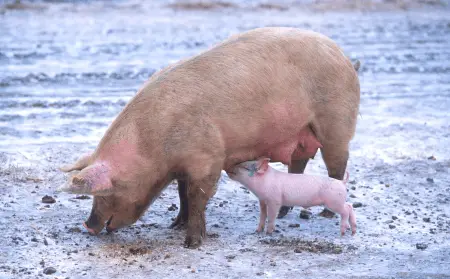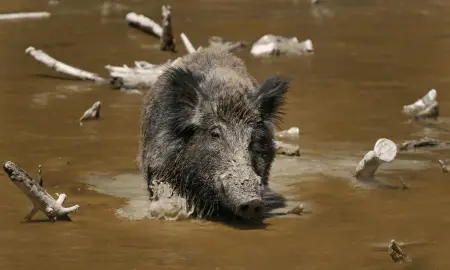Try posting an image of a pig-like animal on social media and asking what animal it is. Although it’s highly likely that you get different responses such as pig, hog, swine or even boar, they would not be all wrong.
Let’s find out why.
Definitions
The word hog usually refers to an older and bigger domesticated pig weighing more than 54 kilograms or 120 lbs. It is also a British term for a fully-grown castrated male pig.
Some hunters would also call a wild boar a hog.

A pig is part of the Sus genus under the Suidae family. The word pig describes ten currently known living species, including domesticated pigs (Sus scrofa domesticus), forest hogs, babirusas, warthogs, red river boars and bushpigs. Man has domesticated pigs since ancient times, about 5,000 to 7,000 years ago.
Pigs are omnivores, feeding on plants and animals. In livestock farms, their diet includes soybean meals and corn combined with vitamins and minerals. Wild boars are foraging animals that feed on leaves, fruits, grasses and flowers. These animals love wallowing in mud to keep their bodies cool and get rid of parasites.
Pigs are intelligent and very social animals.
They can be trained to do many tasks and tricks.
Commercially raised domesticated pigs (i.e., swine) are the source of pork, gammon, bacon, ham and even some leather. Pork makes up 38 percent of the meat produced all over the world, and it is one of the most preferred meats for human consumption. The bristly hair that grows on pigs was once used in paintbrushes.
Adult pigs in livestock farms are given names according to their gender. Adult male pigs are called boars, while females are called sows. Piglets are young pigs.

The boar, or wild boar (Sus scrofa), is the ancestor of domestic pigs. Archeological findings suggest that wild boars were tamed thousands of years ago to become today’s domesticated pigs.
A wild boar has a strong and massively built body with short and thin legs.
It has a short but bigger trunk and a short, thick neck for plowing the ground. Its head is big, almost making up a third of its body length. Its well-developed canine teeth usually protrude from its mouth.
Hog vs Pig vs Boar
So what’s the difference between a hog, pig, and boar?
It is important to remember that all three refer to one thing – pigs. There are no clear-cut differences between these terms as farmers, hunters and regular folks use them interchangeably. However, farmers and hunters tend to be more “technical” in their usage of these terms to sort pigs out depending on the sex of the animal, whether it’s domesticated or not and which stage in life the animal is in.
Hog farmers would call an older, bigger domesticated pig weighing more than 54 kilograms (120 pounds) a hog. The word pig commonly describes all species under the Suidae family, which includes hogs and boars. While wild boars have slight physical differences from their domesticated relatives, they are still pigs. Farm pigs are domesticated pigs, while pigs living in the wild are simply wild pigs.





